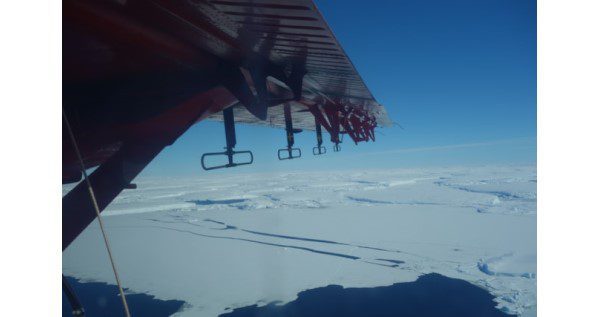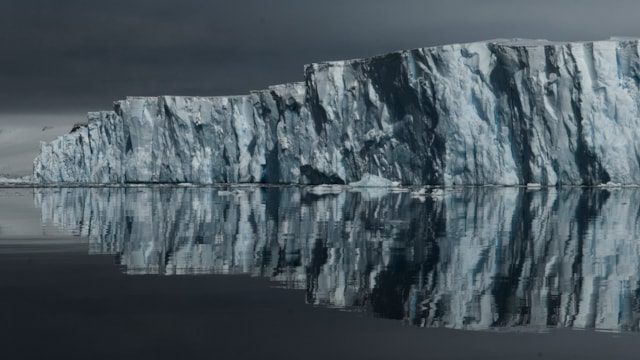Cambridge: A vast area of the Antarctic Ice Sheet continues to retreat as a UK-US group of scientists reveal new findings about how and when it might suddenly move towards collapse.
Since 2018, researchers have uncovered a complex, rapidly changing environment at the remote Thwaites Glacier in West Antarctica. Scientists from the UK and US are meeting at British Antarctic Survey (BAS) in Cambridge this week (16-20 September) to discuss their observations and study results.
Prior to the start of the project, named the International Thwaites Glacier Collaboration (ITGC), little was known about the mechanisms controlling the retreat of this enormous glacier – one of the largest and fastest-changing glaciers in the world. If it collapsed entirely, sea levels would rise by 65 cm.

Flying over the Glacier.
Thwaites Glacier spans an area equal to the island of Great Britain or the US state of Florida, and in places is over 2000 m (over 6,500 feet) thick. The volume of ice flowing into the sea from Thwaites and its neighbouring glaciers has more than doubled from the 1990s to the 2010s, and the wider region, called the Amundsen Sea Embayment, accounts for 8% of the current rate of global sea level rise of 4.6 mm a year.
The mission of the ITGC is to gain an understanding of the critical physical processes controlling the glacier in the present climate and over the last few thousand years, and to build a more reliable prediction of how the glacier will change in the future and why.

Dr Kelly Hogan with a corer. Linda Welzenbach. Scientists have researched the physical processes controlling the glacier in the present climate and over the last few thousand years
“Thwaites has been retreating for more than 80 years, accelerating considerably over the past 30 years, and our findings indicate it is set to retreat further and faster,” according to Dr Rob Larter from the Science Coordination of the ITGC and a marine geophysicist at BAS.
The work of ITGC is trying to predict the rate and magnitude of ongoing sea level rises that will have a huge impact on the hundreds of millions of people on coasts from Bangladesh to low-lying Pacific islands, from New York to London.
“There is a consensus that Thwaites Glacier retreat will accelerate sometime within the next century. However, there is also concern that additional processes revealed by recent studies, which are not yet well enough studied to be incorporated into large scale models, could cause retreat to accelerate sooner.”
The findings suggest Thwaites Glacier and much of the West Antarctic Ice Sheet could be lost by the 23rd century. Thwaites Glacier is exceptionally vulnerable because its ice rests on a bed far below sea level that slopes downwards towards the heart of West Antarctica.
Thwaites Glacier and much of the West Antarctic Ice Sheet could be lost by the 23rd century.
Using advanced technology such as underwater robots, novel survey techniques, and new approaches to ice flow and fracture modelling, the scientists have gained new insights into these processes. This has improved the performance of predictive computer models, but much remains to be understood about the glacier’s future.
The colossal Thwaites, at roughly 120 km across, is the widest glacier on the planet. It is also a keystone of the West Antarctic Ice Sheet, much of which sits on a bed below sea level and would raise sea levels by 3.3 metres if it all melted.
The Nathaniel B Palmer and sea ice. Rob Larter, BAS. Thwaites Glacier is a keystone of the West Antarctic Ice Sheet.
“It’s concerning that the latest computer models predict continuing ice loss that will accelerate through the 22nd century and could lead to a widespread collapse of the West Antarctic Ice Sheet in the 23rd,” according to Dr Ted Scambos, US science coordinator of the ITGC and glaciologist at the University of Colorado.
He continued, “Immediate and sustained climate intervention will have a positive effect, but a delayed one, particularly in moderating the delivery of warm deep ocean water that is the main driver of retreat.”
The ITGC is funded by the US National Science Foundation and UK Natural Environment Research Council.
More information
Thwaites Glacier is retreating with warmer water in the Amundsen Sea thawing the underside of the ice, particularly in the region of the grounding zone, where the ice is lifted and lowered off the seabed by tides.
Under the worst-case scenario, fast-collapsing ice cliffs of 100 metres height or more would form at the front of the Thwaites and rapid, repeated calving of icebergs from them would lead to runaway retreat. Worryingly, the ITGC also detected previously unknown processes in which tides could weaken the ice. In the zone where Thwaites rests on the seabed, warmer water seeps underneath as the tide rises. When the tide falls, the water is pumped at high pressure up to 10 km under the ice. This rising and falling may accelerate melting at the base of the glacier, allowing it to slide faster into the sea.
Among the scientific discoveries, a torpedo-shaped robot known as Icefin, lowered through a 600m deep hole drilled through the ice shelf with hot water, found that a thin layer of cold water insulates much of the flat-lying underside of the ice, slowing the thaw. However, stronger melting was found in other areas where the ice base is tilted more steeply, and at cracks in the bottom of the ice. The ITGC also developed maps of ridges and channels on the seabed, helping understand how natural “pinning points” can slow the flow of Antarctica’s glaciers.
The Intergovernmental Panel on Climate Change says global sea levels are likely to rise this century by between about 40 cm and 80 cm, depending on future greenhouse gas emissions. The rise is driven by melting and ice flow in Greenland, Antarctica, and the world’s mountain glaciers, and the natural expansion of ocean water as it warms.
In a worst, low likelihood future of ice sheet instability, the IPCC has estimated that sea levels could rise by up to almost two metres by 2100.
The ITGC is the biggest US-UK research project in the frozen continent since a joint mapping of West Antarctica in the late 1940s, and includes scientists and other contributions from nations such as South Korea, Germany and Sweden.
About the International Thwaites Glacier Collaboration
The International Thwaites Glacier Collaboration (ITGC) is multi-year research collaboration, funded jointly by the UK Natural Environment Research Council (NERC) and the U.S. National Science Foundation (NSF), bringing together over 100 polar scientists from leading UK and U.S. research organisations.
The ITGC is the largest Antarctic research project undertaken by the two nations since the 1940s. Their mission is to deploy teams of researchers, using a suite of technologies to investigate changes on the ice and in the ocean. Their goal is to investigate the implications of a major glacier collapse on future sea level rise.
For more information about the ITGC, visit thwaitesglacier.org
About British Antarctic Survey
The British Antarctic Survey strives to uncover the secrets of the Polar Regions and the frozen regions of the Earth. Our expertise spans the depths of the oceans to the inner edge of space.
Our research highlights the fragility of the Earth’s frozen environments, and what that means for our planet. We have been living and working in the extremes of Antarctica and the Arctic for over 60 years. Our scientists discovered the hole in the ozone layer and identified key evidence for climate change in ancient ice – our science continues to inform decision-makers. We provide the UK’s national polar capability by operating research stations, aircraft and Royal Research Ship Sir David Attenborough, supporting science at the poles and securing the UK’s presence in Antarctic affairs. Find us at: www.bas.ac.uk
The British Antarctic Survey is part of the Natural Environment Research Council (NERC). NERC is part of UK Research and Innovation (UKRI).
About NSF
The U.S. National Science Foundation propels the nation forward by advancing fundamental research in all fields of science and engineering. NSF supports research and people by providing facilities, instruments and funding to support their ingenuity and sustain the U.S. as a global leader in research and innovation. With a fiscal year 2024 budget of $9.06 billion, NSF funds reach all 50 states through grants to nearly 2,000 colleges, universities and institutions. Each year, NSF receives more than 40,000 competitive proposals and makes about 11,000 new awards. Those awards include support for cooperative research with industry, Arctic and Antarctic research and operations, and U.S. participation in international scientific efforts. Find out more at https://www.nsf.gov/
About the Natural Environment Research Council (NERC) NERC is the U.K.’s main agency for funding and managing research, training and knowledge exchange in the environmental sciences. Our work covers the full range of atmospheric, Earth, biological, terrestrial and aquatic science, from the deep oceans to the upper atmosphere and from the poles to the equator. We coordinate some of the world’s most exciting research projects, tackling major issues such as climate change, environmental influences on human health, the genetic make-up of life on Earth, and much more. NERC is part of U.K. Research and Innovation, a non-departmental public body funded by a grant-in-aid from the U.K. government. Find out more at nerc.ukri.org
